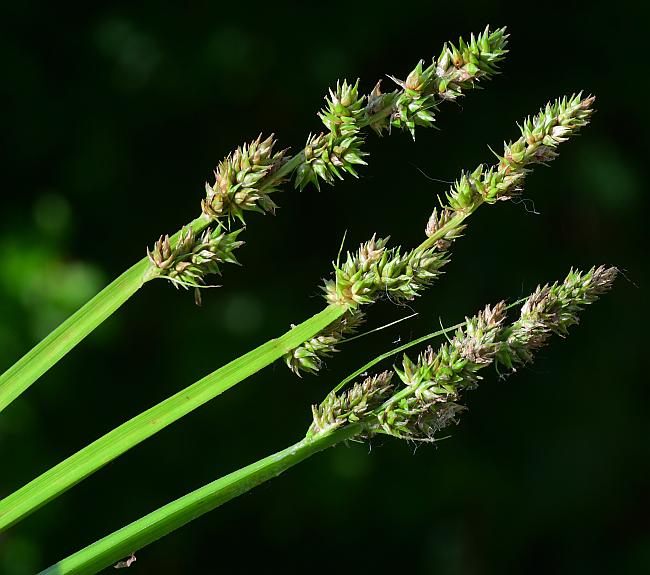Carex conjuncta Boott
Soft Fox Sedge

Native
CC = 5
CW = -3
MOC = 77
© SRTurner
Carex conjuncta BoottSoft Fox Sedge | |
 |
Native CC = 5 CW = -3 MOC = 77 |
© SRTurner |
|
Family - Cyperaceae, Carex section Vulpinae Habit - Monoecious sedge with short rhizomes, forming clumps. Stems - Flowering stems to 1.0 m, winged and sharply trigonous, stout in appearance but easily compressed, glabrous. Leaves - Blades 2-40 cm long, 3-10 mm wide, green. Leaf sheaths often extended slightly beyond the attachment point of the leaf blade, convex at the tip, the dorsal side white with green veins or mottled green and white, also with scattered, short, dark green or brown cross-lines (these actually darkened cross-walls of the cells, clearly visible with magnification), the ventral side thin, papery, white with scattered red dots, cross-wrinkled and sometimes breaking up at maturity, the ligule longer than wide and U-or V-shaped.
Inflorescences - Compound with relatively short basal branches, with 10-20 spikes.
Perigynia - Pistillate scales 2.5-4.0 mm long, white or nearly so with a green or straw-colored midrib. Perigynia 3.5-4.5 mm long, 1.6-2.0 mm wide, ovate in outline, green, the tip tapered abruptly to a short beak about 1/2 as long as the main body, the base rounded, straw-colored, somewhat swollen with spongy tissue but continuous with the main body and not differentiated into a disklike structure, the ventral surface nerveless or with several short, faint nerves near the base of the main body, the dorsal surface with 3-5 strong nerves. Fruits 1.5-2.2 mm long.
Flowering - May - June. Habitat - Bottomland forests and prairies, moist depressions of upland prairies, streambanks, ditches. Origin - Native to the U.S. Other info. - This sedge is found across most of Missouri, and is relatively common. Beyond Missouri its range extends in a scattered band mostly eastward, not quite reaching the Atlantic Coast. Visually, this species is distinguished by crowded, elongate inflorescences atop stout-looking but winged and easily crushed stems. The leaf sheaths are loose, with the side opposite the leaf blade thin and wrinkled. Separate staminate spikes are not produced, but instead the spikes have staminate flowers at the their tips. These are so inconspicuous that they can be hard to find. The perigynia are teardrop-shaped and flattened, with a whitened basal area which internally contains soft amorphous material. Photographs taken at Weldon Spring Conservation Area, St. Charles County, MO, 6-2-2020 (SRTurner). |